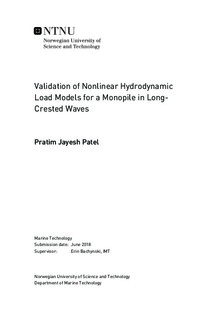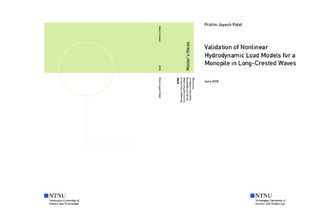| dc.description.abstract | This Master Thesis studies an offshore wind turbine supported by a monopile structure. Model tests for a fully flexible monopile were carried out in the Ocean Basin facility at SINTEF Ocean in August 2017, through the NOWITECH project. This thesis examines selected results from the experiments and introduces numerical simulations for comparison to the experimental results. For the numerical simulations the software SIMA RIFLEX, a finite element solver for static and dynamic analysis of slender marine structures, is utilized. The main focus has been put on validation of hydrodynamic load models, both linear and nonlinear, that can describe the response from the experiments, both on a statistical level and for single events.
A literature review regarding nonlinear hydrodynamic load models and ringing responses is performed. The literature review focuses on observations of ringing responses and the mechanisms that lead to ringing.
A beam element model was built in SIMA and presented by the Supervisor as a starting point to this thesis. The model was calibrated based on available decay tests from the experiments to have the same system damping ratio (0.47%) and first mode eigenfrequency (1.42 rad/s) as the experimental model. The damping ratio was estimated as 0.47%, which is considered to be relatively low compared to similar monopile supported offshore wind turbines in full scale, where damping ratios have been found up to 2.8%. An eigenvalue analysis was also conducted to confirm the eigenfrequencies found from the decay tests. The eigenvalue analysis also conveniently provided the modal shapes of the three first bending modes.
Regular wave tests were treated to establish the RAOs for first, second and third order. The first-order RAOs displayed a reasonable behaviour with good agreement between the simulated and experimental. The second order RAO also showed good agreement between the simulated and experimental results, except for one wave period, T = 9 s, where a strong over-prediction was made in the simulations. For the simulations of the regular wave tests, Morison's equation with linear kinematics was used together with the MacCamy-Fuchs correction for diffraction. However, only linear diffraction is accounted for by this method. The over-prediction may be a result of not taking second order diffraction effects into account in the simulations. The third order RAOs were of an order of magnitude lower than the first and second order RAOs. Thus, some uncertainty due to accuracy of measurements were connected to the third order RAOs.
A repeatability analysis for the experiments was performed for nine repeated irregular wave tests. The repeatability analysis revealed through the coefficient of variation that the random error connected to global maxima for the moment response was below 10%, indicating quite good repeatability. A considerably larger random error, far above 10%, was connected to the repetition of the magnitude of single event maxima. The coefficient of variation was also considered for the maximum wave amplitude at two different wave probes. This revealed that both global maxima and single event maxima were repeated quite well, with coefficient of variation below 10%.
A parameter study on the damping was initiated as the damping in the system, estimated from the decay tests was very low. Realistic damping ratios were found in the literature and considered. It is found that the originally estimated damping ratio is likely to not be representative of the system damping when the structure is subjected to waves. This is suggested based on the simulations with linear theory overestimating the response from the experimental tests, which is contradictory to what is found in the literature when considering extreme sea states. If a more realistic damping ratio of 1.1% is accepted as the damping ratio for the structure, it is found that linear wave kinematics with Wheeler stretching is the most appropriate method for describing the energy in the response from the experimental tests.
Ringing responses were identified in the experimental tests and were in agreement with how the phenomenon is described in the literature. It is found in the experiments that ringing responses are initiated by large, steep wave events. The ringing events characteristically have a large amplification from the steady state response and decays with the eigenfrequency for some periods. Clear ringing events were not found in the simulations. More likely than not, higher order than second order theory must be considered to properly describe the ringing phenomenon. | |

